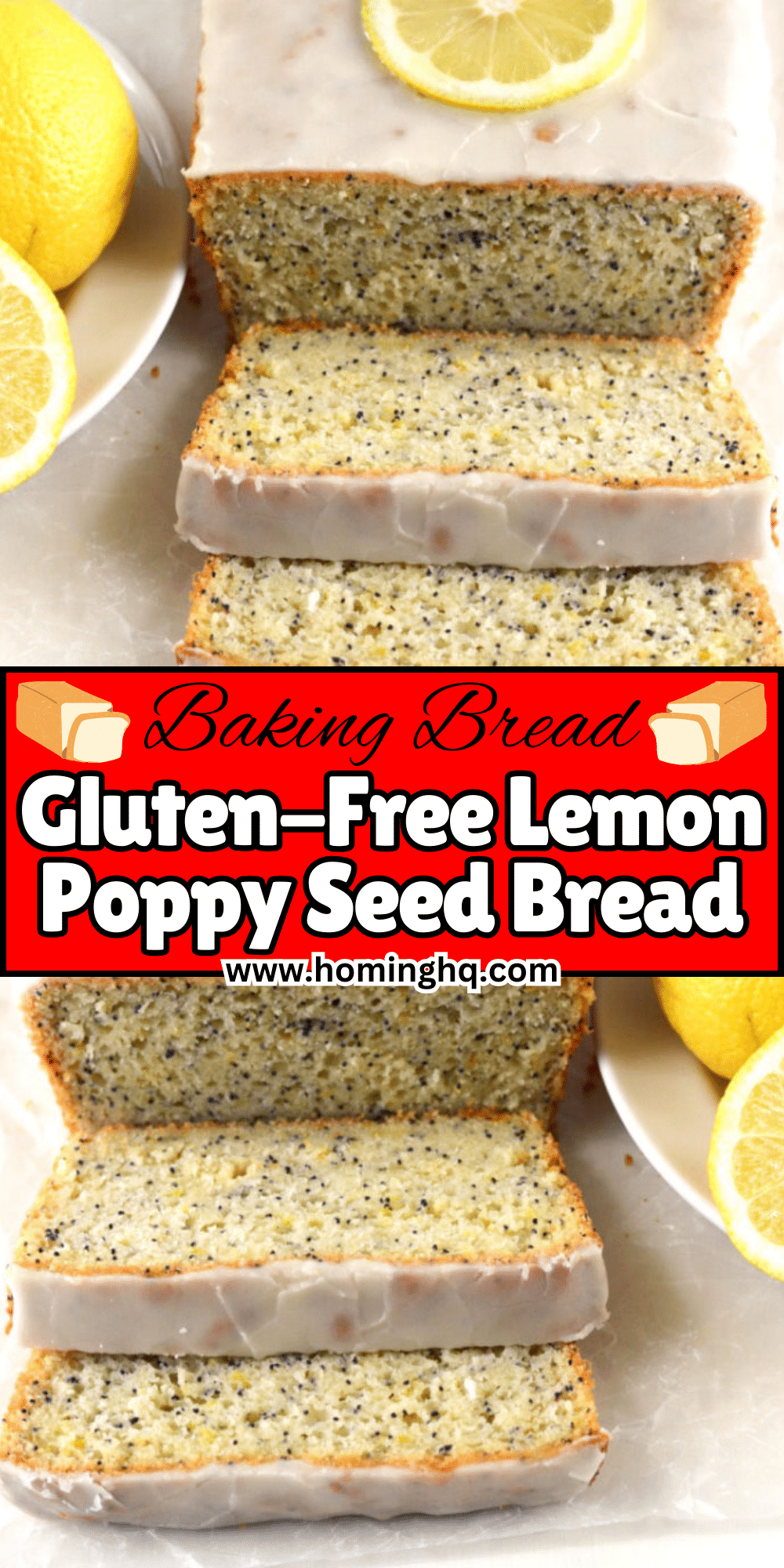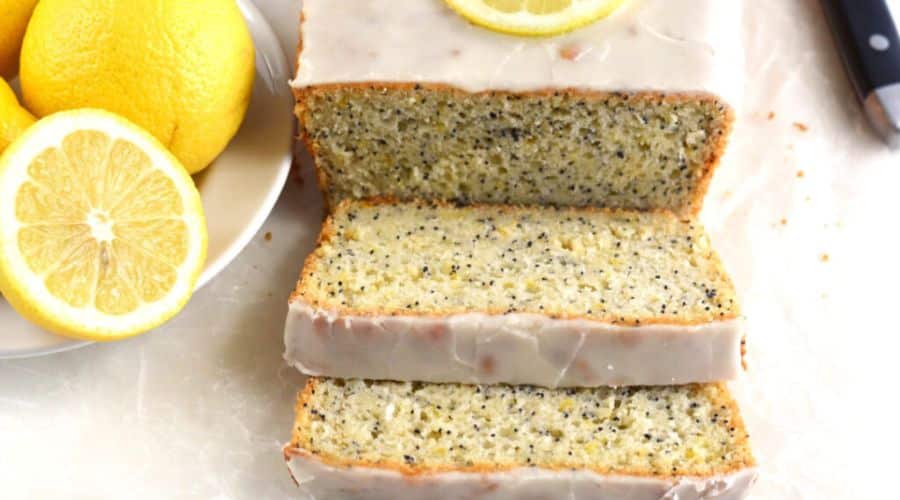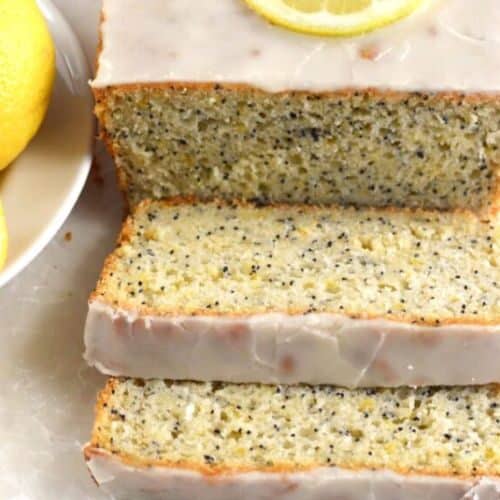All products are selected by our editorial team for quality. If you buy through our links, we may earn a small commission at no extra cost to you.
If you love a bright, citrusy treat that’s both moist and tender, this Gluten-Free Lemon Poppy Seed Bread is just what you need.
Bursting with fresh lemon flavor and the subtle crunch of poppy seeds, this loaf is perfect for breakfast, an afternoon snack, or even a light dessert.
Unlike some gluten-free baked goods that can turn out dry or crumbly, this recipe delivers a soft and fluffy texture—thanks to a carefully balanced mix of ingredients.
Whether you’re following a gluten-free diet or simply looking for a delicious homemade bread, this easy-to-make recipe is sure to impress.

Why You’ll Love This Recipe
- Gluten-Free Yet Moist and Fluffy – Made with a high-quality gluten-free flour blend, this bread has a soft crumb that rivals traditional versions.
- Packed with Lemon Flavor – Fresh lemon juice and zest add a bright, refreshing taste.
- Perfectly Sweet and Slightly Nutty – The poppy seeds bring a gentle crunch, complementing the citrusy sweetness.
- Versatile and Easy to Make – Whether you enjoy it plain, drizzled with a glaze, or topped with butter, this bread is always a delight.
Ingredients You’ll Need
Dry Ingredients:
- Gluten-Free Flour Blend – Choose a 1:1 gluten-free baking flour for the best results.
- Baking Powder & Baking Soda – Helps the bread rise beautifully.
- Poppy Seeds – Adds texture and a mild, nutty flavor.
- Salt – Balances the sweetness and enhances the lemon notes.
Wet Ingredients:
- Eggs – Provides structure and helps with fluffiness.
- Granulated Sugar (or Honey/Maple Syrup) – Sweetens the bread just right.
- Lemon Zest & Fresh Lemon Juice – The key to a bright, citrusy taste.
- Greek Yogurt (or Dairy-Free Alternative) – Adds moisture and tenderness.
- Vanilla Extract – Enhances the overall flavor.
- Melted Butter (or Coconut Oil) – Contributes to a soft, rich texture.
Step-by-Step Instructions

Step 1: Prepare Your Ingredients & Oven
Preheat your oven to 350°F (175°C) and grease a 9×5-inch loaf pan. If you prefer, line it with parchment paper for easy removal.
Zest and juice the lemons, making sure to remove any seeds.
Step 2: Mix the Dry Ingredients
In a medium bowl, whisk together the gluten-free flour, baking powder, baking soda, poppy seeds, and salt. Set aside.
Step 3: Prepare the Wet Mixture
In a large mixing bowl, beat the eggs and sugar until light and slightly fluffy.
Add the lemon zest, lemon juice, Greek yogurt, melted butter, and vanilla extract, stirring until well combined.
Step 4: Combine & Bake
Slowly add the dry ingredients to the wet mixture, folding gently until no streaks of flour remain. Avoid overmixing, as this can make the bread dense.
Pour the batter into the prepared loaf pan and smooth out the top.
Bake for 45-50 minutes, or until a toothpick inserted in the center comes out clean.
Step 5: Cool Before Adding Glaze
Let the bread cool in the pan for 10 minutes, then transfer to a wire rack to cool completely before glazing.
Optional Lemon Glaze
A simple lemon glaze takes this bread to the next level, adding a glossy finish and extra citrusy sweetness.
Ingredients for the Glaze:
- 1 cup powdered sugar
- 2-3 tablespoons fresh lemon juice
- ½ teaspoon vanilla extract (optional)
How to Make the Glaze:
Whisk together powdered sugar, lemon juice, and vanilla extract until smooth. If the glaze is too thick, add a little more lemon juice; if too thin, add more powdered sugar.
Once the bread has completely cooled, drizzle the glaze over the top and let it set before slicing.
Would you like me to continue with the remaining sections?
Tips for the Best Gluten-Free Lemon Poppy Seed Bread
Use the Right Gluten-Free Flour Blend
Not all gluten-free flours work the same way.
For the best results, use a 1:1 gluten-free baking flour blend that contains xanthan gum or another binder.
This helps create a soft, cohesive texture similar to traditional wheat-based bread.
Measure Flour Correctly
Gluten-free flour can be denser than all-purpose flour.
Spoon the flour into your measuring cup and level it off with a knife instead of scooping directly from the bag, which can lead to too much flour and a dry loaf.
Don’t Overmix the Batter
Since gluten-free flours don’t develop gluten strands, overmixing can make the bread dense rather than light and airy.
Stir just until the dry ingredients are incorporated.
Let the Batter Rest
Allowing the batter to sit for 5-10 minutes before baking gives the flour time to absorb the liquid, leading to better texture and structure.
Check for Doneness Properly
Gluten-free baked goods often need a little extra baking time.
Insert a toothpick into the center—it should come out clean or with just a few crumbs.
If the top is browning too quickly, cover it loosely with foil for the last 10 minutes.
Cool Completely Before Slicing
Gluten-free bread is delicate when warm.
Let it cool fully on a wire rack before slicing to prevent crumbling.
How to Store & Freeze
- At Room Temperature: Store in an airtight container for up to 3 days.
- In the Refrigerator: Keeps for up to 5 days but may dry out slightly.
- Freezing: Wrap tightly in plastic wrap and store in a freezer bag for up to 3 months. Thaw at room temperature before serving.
Variations and Substitutions
Make It Dairy-Free
Swap out the Greek yogurt for coconut yogurt or almond milk yogurt and use coconut oil or a vegan butter substitute instead of butter.
Lower the Sugar
Instead of granulated sugar, try:
- Coconut sugar for a more natural sweetness
- Honey or maple syrup (reduce other liquids slightly to balance the moisture)
Try Almond Flour for a Grain-Free Option
You can replace part of the gluten-free flour blend with almond flour (about ¼ cup) to add richness and a slightly denser texture.
However, do not fully substitute, as almond flour alone won’t provide the right structure.
Add a Flavor Boost
- Blueberries or Raspberries: Gently fold in ½ cup of fresh or frozen berries before baking for extra fruitiness.
- Nuts: Chopped almonds or walnuts add crunch and depth.
- Coconut: Mix in unsweetened shredded coconut for a tropical twist.
Make It Into Muffins
Pour the batter into a lined muffin tin and bake at 350°F (175°C) for 18-22 minutes, or until a toothpick comes out clean.
Would you like me to continue with Serving Suggestions & FAQs?
Serving Suggestions
Enjoy It as a Classic Treat
This Gluten-Free Lemon Poppy Seed Bread is delicious on its own, offering a perfect balance of citrusy brightness and nutty crunch.
Enjoy a slice with your morning coffee or tea for a refreshing start to your day.
Top It with Your Favorite Spread
For an extra indulgent touch, try:
- Butter or Dairy-Free Spread – Enhances the richness and soft texture.
- Cream Cheese or Mascarpone – Adds a slight tang that pairs beautifully with the lemon flavor.
- Lemon Curd or Honey – Boosts the citrusy sweetness.
Turn It Into a Dessert
- Warm a slice in the oven or microwave and serve with a scoop of vanilla or lemon sorbet.
- Top with fresh berries and whipped cream for a light yet satisfying treat.
Pair with Beverages
- A hot cup of tea (chamomile, earl grey, or green tea) enhances the citrus notes.
- A latte or cappuccino complements the bread’s slight sweetness.
- For a refreshing summer treat, pair it with iced tea or lemonade.
Final Thoughts
This Gluten-Free Lemon Poppy Seed Bread is a delightful balance of bright, zesty flavors and a tender, moist crumb.
Whether you’re making it for a casual breakfast, a sweet afternoon snack, or a simple dessert, this loaf is sure to be a crowd-pleaser.
With easy substitutions and variations, you can customize it to fit your dietary needs without sacrificing taste or texture.
Try it as muffins, add berries, or drizzle with a glaze—the possibilities are endless!
If you make this recipe, let us know in the comments how it turned out. We’d love to hear your favorite ways to enjoy this gluten-free treat!
Frequently Asked Questions (FAQs)
1. Can I use almond flour instead of a gluten-free flour blend?
You can replace up to ¼ cup of the gluten-free flour with almond flour for a richer texture.
However, using only almond flour will not provide enough structure, so it’s best to use a blend for the best results.
2. How do I prevent my gluten-free bread from being too dry?
Make sure to use Greek yogurt or a similar high-moisture ingredient.
Also, avoid overbaking, and measure your flour properly using the spoon-and-level method rather than scooping directly from the bag.
3. Can I make this recipe egg-free?
Yes! Substitute the eggs with:
- 2 flax eggs (2 tablespoons ground flaxseed + 5 tablespoons water, let sit for 5 minutes)
- 1 mashed banana (for added sweetness)
- ½ cup unsweetened applesauce
4. How long does this bread stay fresh?
Stored in an airtight container at room temperature, it stays fresh for up to 3 days. If refrigerated, it lasts up to 5 days, and if frozen, up to 3 months.
5. Can I turn this recipe into muffins?
Yes! Simply divide the batter into a lined muffin tin and bake at 350°F (175°C) for 18-22 minutes, or until a toothpick comes out clean.
Would you like any additional tweaks or another section added?

Gluten-Free Lemon Poppy Seed Bread
Equipment
- 1 medium mixing bowl
- 1 large mixing bowl
- 1 Hand whisk or electric mixer
- 1 9×5-inch loaf pan
- 1 Zester or microplane
- 1 Citrus juicer (optional)
- 1 measuring cup set
- 1 measuring spoon set
- 1 Silicone spatula
- 1 Wire cooling rack
Ingredients
For the Bread:
- 1 ¾ cups 220g Gluten-free 1:1 baking flour
- 1 teaspoon Baking powder
- ½ teaspoon Baking soda
- ¼ teaspoon Salt
- 1 ½ tablespoons Poppy seeds
- 2 large Eggs
- ¾ cup 150g Granulated sugar (or coconut sugar)
- ¼ cup 60ml Fresh lemon juice (about 2 lemons)
- Zest of 2 Lemons
- ½ cup 120g Greek yogurt (or dairy-free alternative)
- ⅓ cup 80ml Melted butter (or coconut oil)
- 1 teaspoon Vanilla extract
For the Optional Lemon Glaze:
- 1 cup 120g Powdered sugar
- 2-3 tablespoons Fresh lemon juice
- ½ teaspoon Vanilla extract optional
Instructions
Step 1: Preheat & Prepare the Loaf Pan
- Preheat your oven to 350°F (175°C). Grease a 9×5-inch loaf pan with butter or non-stick spray, or line it with parchment paper for easy removal.
Step 2: Mix the Dry Ingredients
- In a medium bowl, whisk together the gluten-free flour, baking powder, baking soda, salt, and poppy seeds. Set aside.
Step 3: Prepare the Wet Mixture
- In a large bowl, whisk the eggs and sugar until light and fluffy. Add the lemon juice, lemon zest, Greek yogurt, melted butter, and vanilla extract, mixing until smooth.
Step 4: Combine Wet & Dry Ingredients
- Gradually fold the dry ingredients into the wet mixture, stirring until just combined. Avoid overmixing to maintain a light texture.
Step 5: Bake the Bread
- Pour the batter into the prepared loaf pan and smooth the top. Bake for 45-50 minutes, or until a toothpick inserted into the center comes out clean.
Step 6: Cool Completely
- Let the bread cool in the pan for 10 minutes, then transfer it to a wire rack to cool completely before adding glaze.
Step 7: Prepare the Lemon Glaze (Optional)
- In a small bowl, whisk together powdered sugar, lemon juice, and vanilla extract until smooth. Adjust consistency if needed.
Step 8: Glaze & Serve
- Drizzle the glaze over the cooled bread. Let it set for a few minutes before slicing and serving.
Notes
- Flour Choice: A 1:1 gluten-free baking flour blend with xanthan gum works best. Avoid single-ingredient flours like almond or coconut alone.
- Storage: Store in an airtight container at room temperature for up to 3 days or refrigerate for up to 5 days. Freeze for up to 3 months.
- Dairy-Free Option: Substitute Greek yogurt with coconut yogurt and butter with coconut oil or dairy-free butter.
- Muffin Variation: Divide batter into muffin tins and bake at 350°F (175°C) for 18-22 minutes.

